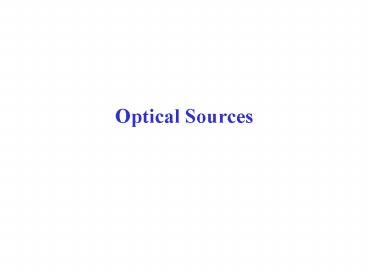Optical Sources - PowerPoint PPT Presentation
Title: Optical Sources
1
Optical Sources
2
History of Lasers
- In 1917, Einstein predicted the existence of
spontaneous and stimulated emission by which an
atom can emit radiation. - To make use of the stimulated emission for the
construction of coherent optical sources Townes
and Schawlow in the US and Basov and Prochorov in
the USSR. - In 1960- Maiman demonstrated the first laser.
3
The Einstein Coefficients
N2
E2
hw
E1
N1
4
The Einstein Coefficients
5
The Einstein Coefficients
6
The Einstein Coefficients
7
Example 1
8
Population inversion
- Light amplification can take place only if Rstgt
Rabs or - N2 gt N1.
- Under thermal equilibrium, it is N1 gt N2 .
Therefore, N2 - should be increased by external means. The
condition N2 gt N1 - is referred as population inversion.
9
Review of Semiconductor Physics
10
Review of Semiconductor Physics
11
Example 2
12
Direct and Indirect Band Gaps
13
P-N Junctions
p-type
n-type
14
P-N Junctions
15
Non-radiative recombination
16
Non-radiative recombination
17
Light emitting diode (LED)
- LED is a forward-biased p-n homojunction or
heterojunction. - Radiative recombination of electron-hole pairs in
the depletion region generates light. - For LEDs, radiative recombination of holes and
electrons is dominated by spontaneous emission
and stimulated emission is negligible. - The emitted light is incoherent with a relatively
wide spectral width (30-60 nm) and a relatively
large angular spread. - For bit rates less than 100-200 Mb/s together
with multimode fibers, LEDs are usually the best
light source. - LEDs can not be used for long haul WDM systems
because of their large spectral width.
18
LED Light-Current Characteristics
19
LED Light-Current Characteristics
20
LED Light-Current Characteristics
21
Example 3
22
Example 3
23
Laser diode (LD)
- Laser diodes emit light through stimulated
emission while LEDs emit light through
spontaneous emission. - Laser diodes can emit high powers (100 mW) and
also it is coherent. - A relatively narrow angular spread of the output
beam compared with LEDs permit high coupling
efficiency. - A relatively narrow spectral width of LD makes it
a suitable candidate for wavelength division
multiplexing (WDM) applications.
24
Laser diode (LD)
- When a photon of energy hf impinges on the
system, electrons in the valence band can be
excited to conduction band. This is called
absorption. - Electrons in the conduction band are also
stimulated to make a transition to valence band
in the presence of a photon of energy hf which is
equal to the band gap energy. This is called
stimulated emission. - Electrons in the conduction band could emit a
photon of energy hf without any external
stimulation and go to valence band. This is
spontaneous emission. - The stimulated emission exceeds absorption only
if the number of electrons in the excited state
exceeds that in ground state. This condition is
known as population inversion. - Population inversion is achieved by various
pumping techniques. In semiconductor lasers,
population inversion is accomplished by injecting
electrons into the semiconductor material.
25
Light Amplification by Stimulated Emission for
Two Level Systems
26
Light Amplification by Stimulated Emission
27
Optical Feedback and Laser Threshold
28
Optical Feedback and Laser Threshold
29
Optical Feedback and Laser Threshold
30
Example 4
31
Optical Feedback and Laser Threshold
32
DFB and DBR Semiconductor lasers
33
Laser Diode Rate Equations
34
Laser Diode Rate Equations
35
Laser Diode Rate Equations
36
Example 5































